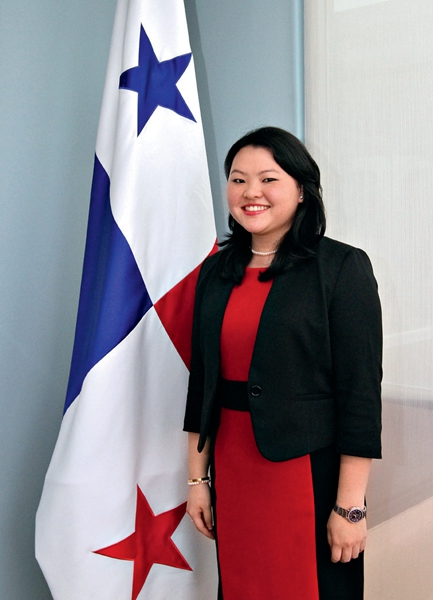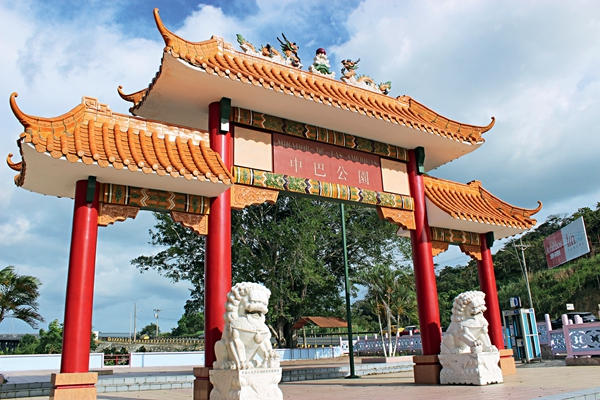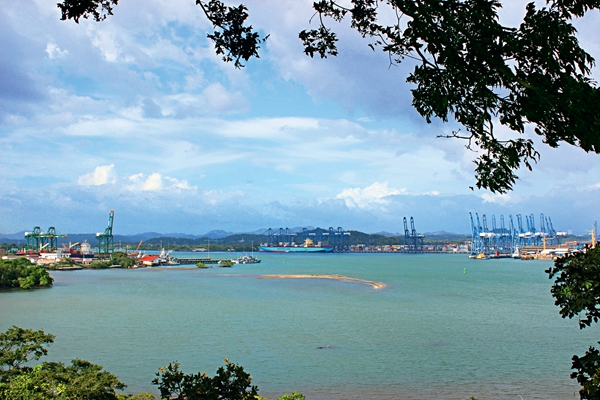Panama – Connecting China with Latin America
By staff reporter MICHAEL ZÁRATE
ON the evening of June 12 (the morning of June 13 in China), the President of Panama, Juan Carlos Varela, announced his decision to establish diplomatic relations with the People’s Republic of China. However, over the years, Panama had never turned a blind eye to the Asian country. In fact, this diplomatic decision began to form almost 40 years ago, as attested to by several former officials of the Panamanian government. In 1995, both countries agreed to establish commercial business development offices. Moreover, Panama serves as one of the most important places for Chinese communities in Latin America.

“It seemed to some people that after the invasion (of Panama by the United States in 1989) we would have a kind of umbilical cord with the U.S., but we must take our own steps to consolidate our autonomy in international relations. The establishment of relations with China is a good expression of this,” said Leonardo Kam in an interview with China Today in Panama City.
Leonardo Kam was the third commercial representative of Panama in the People’s Republic of China and one of the facilitators of the establishment of diplomatic relations between the two countries. “This was a maturing process that paid off on June 12, so it is a measure that I celebrate. As many as 98 percent of Chinese Panamanians are descended from China’s mainland. I myself am 50 percent Chinese,” Kam added.
A Key Destination
On July 1, before attending a session of the National Assembly of Panama, Commerce and Industry Minister Augusto Arosemena said that “Panama will be the bridge between China and Latin America.” Moreover, on June 12, the same day that the establishment of relations with China was announced, Panama launched its new national brand, promoting itself as an ideal destination for foreign investment in Latin America under the motto “Panama: The Great Connection.” It is important to remember that Panama is located in a strategic geographical area.
“Panama has always been a viable route throughout history,” said Any Lam Chong Leon, former representative of the Panama-China Trade Development Office in Beijing and now charge d’affaires of the country’s embassy in China. As history has shown, for 500 years, the Isthmus of Panama has been an essential trade route between the Atlantic and Pacific Oceans. For this reason, the participation of Panama in the “21st-Century Maritime Silk Road” promoted by the Chinese government is now gathering importance.

“We want to be part of this initiative, and we will try to advance it,” said Any Lam Chong Leon, whose parents emigrated to Panama 35 years ago from the Chinese city of Zhongshan, Guangdong Province. “Panama and China are two developing countries that agree on the importance of globalization and the shared responsibilities of countries in terms of their global development agenda. I do not doubt that we will participate in the Chinese initiative,” she added.
In fact, on June 7 – five days before the announcement of the establishment of diplomatic relations – the China Landbridge Group began construction of a container port on Margarita Island, in the Panamanian province of Colón, with an investment of US $1.1 billion. “The purpose is to modernize this deep-water port to play a more important role in the framework of the Belt and Road Initiative,” Bai Yunyi, a journalist of the Chinese newspaper Global Times in Panama, told the CGTN network.
China is currently the second largest user of the Panama Canal, through which, in 2016, 38.6 million tons of cargo went to and from China. In addition, two Chinese consortiums have already been pre-qualified for the construction of the fourth bridge over the Panama Canal, through which will pass five percent of the world’s maritime trade. China is also the leading supplier of goods in the Colón Free Zone, the largest free trade zone in Latin America, located on the Atlantic coast of Panama.
Therefore, President Varela’s administration hopes that the establishment of diplomatic relations with China will boost Panamanian exports, which have fallen in recent years (US $817 million in 2014, US $695 million in 2015, and US $635 million in 2016).
Free Trade Pact Anticipated
Panama is the second Central American country to establish diplomatic relations with China. The first was Costa Rica in 2007. One of the first issues Costa Rica and China addressed was the signing of a free trade agreement (FTA), which was finalized in 2011. Therefore, there are many voices in Panama calling for FTA negotiations with China.
Panama’s Commerce and Industry Minister Augusto Arosemena has announced that a delegation from his country will travel to China to pave the way for the possible signing of the FTA. In this regard, the Vice President of the National Council of Private Enterprises of Panama, Severio Sousa, held that an FTA would not only put Panama on a par with other countries in the region that have treaties of this type, but also strengthen the Colón Free Zone’s position as a hub for the redistribution of Chinese goods in the American continent. However, it is not the only project that Panama has in mind.

“After the signing of the Joint Communiqué (on the establishment of diplomatic relations), we have had corresponding meetings on the different agreements and cooperation that we wish to foster,” said Any Lam Chong Leon. The Trade Development Office that she formerly headed has become the Embassy of the Republic of Panama in the People’s Republic of China. “In addition to the FTA, there are many projects that we want to strengthen and implement with China, for example, a maritime agreement as well as agreements in the commercial, technological, educational, cultural, and tourist fields, among others,” she added. On August 22, the President of Panama, Juan Carlos Varela, appointed Francisco Carlo Escobar Pedreschi as Panama’s first ambassador to China.
According to figures from the Chamber of Commerce, Industries and Agriculture of Panama (CCIAP), which cover more than 1,600 companies from 15 economic sectors, Panama exported US $50.9 million worth of goods to China in 2016, an increase of 22.9 percent over the previous year. The main exports were copper waste and scrap, aluminum waste, crustaceans, logs and pre-treated wood, coffee, and coffee substitutes, among others.
According to Sun Jiwen, spokesman of China’s Ministry of Commerce, Panama is the country’s largest trading partner in Central America, with bilateral trade amounting to US $6.38 billion in 2016. China’s direct investment in Panama is more than US $230 million and there are about 30 Chinese companies operating in that country in sectors such as maritime transport, telecommunications, finance, and infrastructure.
Within Panama, one can find financial institutions such as the Bank of China, and multinationals like the telecommunications company Huawei, the oil company Sinopec, the construction firm China Harbor Engineering Co., Ltd., and China State Construction Engineering Corporation. The latter two currently aspire to enter a bid to construct Line 3 of the Panama Metro.
Wang Weihua, former Chinese representative for Panama-China Trade Development Office and now charge d’affaires of the Chinese embassy in the country, said at a press conference that the Chinese government’s trade priorities include the signing of cooperation agreements in the maritime, tourism, and agro-export sectors. The country also plans to sign a phytosanitary agreement to allow Panama’s seafood, tropical fruits, and beef to enter the Chinese market, thereby reaching 1.3 billion potential consumers.
The Panamanian tourism sector also expects that the establishment of diplomatic relations will mean the arrival of Chinese investments in infrastructure, theme parks, highways, and hotels, as pointed out by the Minister of Tourism of Panama, Gustavo Him. In that sense, Panama is already developing a policy to attract Chinese tourists. “The Chinese market is expanding. I have already had meetings with Chinese operators and I have been looking for chances to open charter flights. Cooperation in this aspect is now more important with the establishment of diplomatic relations,” Minister Him told the local press.
The Chinese Community in Panama
Although diplomatic relations were established only several months ago, the ties between China and Panama date back more than 160 years. In 1854, the first group of Chinese workers arrived in Panama to participate in the construction of the trans-Isthmus railway, which united the coasts of the Pacific and the Caribbean, and which served as the main international cargo route until the construction of the Panama Canal.
President Juan Carlos Varela has highlighted the construction of the trans-Isthmus railway as a key factor in the later construction of the famous canal. It should also be noted that on June 26, 2016, a Chinese vessel, the container ship Cosco Shipping Panama, made history by being the first to pass through the recently expanded Panama Canal. “This was also in recognition of the Chinese community in Panama, which has played a significant role in the economic and social development of our country,” said President Varela.
It is estimated that there are more than 150,000 Panamanians of Chinese descent, one of the largest communities in Latin America. “The Chinese presence in Panama is very strong,” says Katiuska Hernández, a Venezuelan journalist who lives in Panama City and works for the Martes Financiero magazine of the Panamanian daily newspaper La Prensa. “Every corner of the capital has a Chinese grocery store, where Panamanians stock up on food, household goods, and general everyday items,” Hernandez added in a dialogue with China Today.
In Panama City there is a district called El Dorado, made up of several middle-class enclaves, which has become a new and thriving Chinatown in the capital. “There are several shopping plazas with Asian restaurants and supermarkets. The Chinese New Year celebrations are a prominent event where the Chinese community holds a big festival to showcase their culture and promote trade,” said Katiuska Hernández, adding that there is a long tradition in Panama of eating Chinese dishes for breakfast.
In fact, thanks to a deep-rooted Chinese presence, rice is now a staple food for Panamanians, as well as the custom of enjoying dim sum and yum cha (dessert and tea from China’s Guangdong Province). Gastronomy is a reflection of the deep ties between the two countries which they hope to strengthen by more exchanges between the two governments and peoples in the future.
